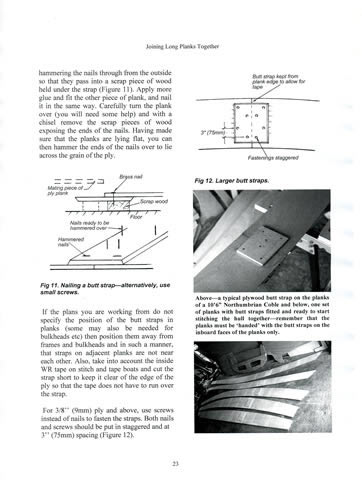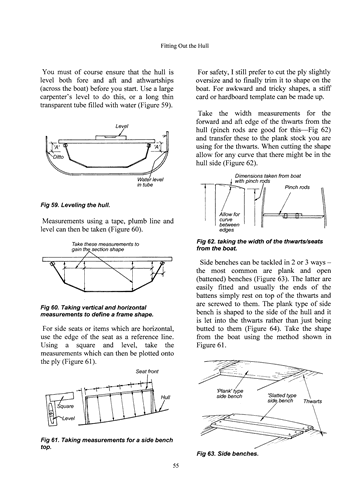All the basics of stitch & tape
This new manual incorporates our old "Manual of Modern Small Plywood Boat Construction Techniques" but now also includes several new sections. These include new chapters on fitting buoyancy (flotation), shaping and constructing masts and spars and an extensive chapter on fitting out the hull with decks, centreboards, seating etc.
Many new photographs and illustrations have been added along with up to date details and description of the modern stitch and tape process. This manual is useful for all builders contemplating and building stitch and tape plywood boats up to 18 or 20' - for plywood boats above this size, see our Manual of Plywood Boat Construction for Larger Craft
Sample Pages



Contents
Chapter 1
Introduction - What is Stitch & Tape Boat Construction?
Chapter 2
Tools, Skills & the Workshop
2.1 Tools
2.2 Skills
2.3 The Workshop
Chapter 3
Material for Stitch & Tape Construction
3.1 Wood
3.1.1 Plywood
3.1.2 Timber (Softwoods)
3.1.3 Timber (Hardwoods)
3.2 Glues & Fastenings
3.3 Developments in Epoxies
3.4 Possible Problems with Epoxies
3.4.1 The Epoxy Will Not Cure
3.4.2 Failure in the Bond of Components being Glued Together
3.4.3 Cloudy Appearance in Epoxy Coatings
3.4.4 Runs in the Epoxy Coating
3.4.5 Other Coating Products will not Cure over Epoxy
Chapter 4
Producing the Hull Planks
4.1 Marking Out the Hull Planks
4.2 Cutting Out the Hull Planks
Chapter 5
Joining Long Planks Together
5.1 General
5.1.1 Butt Straps
5.1.2 Scarf Joining Planks
5.1.3 Saw Tooth or Castellated Join
Chapter 6
Stitching the Planks Together
6.1 Preparing the Planks for Stitching
6.2 Stitching the Planks
6.3 Overcoming Problems with Plywood that will not Bend into Shape
6.4 What to do if a Plank Breaks
6.5 Stitching the Transom in Place
6.6 Final Tightening of the Stitches
Chapter 7
Checking the Shape of the Boat
Chapter 8
Stitch and Tape Seams & Epoxy Filleting Frames etc in Place
8.1 General
8.2 Stitch & Tape using Polyester Resin
8.3 Stitch & Tape using Epoxy Resin
8.3.1 For Small boats & Canoes
8.3.1.1 Omitting the Tapes on the Outside of the Chine Seams
8.3.1.2 Eliminating Tape Bumps on the Outside of the Chine Seam
8.3.2 For Larger Boats
8.3.3 Combination Seam Joints
8.3.4 Bonding Plywood Frames to the Hull
8.3.5 General Notes on Epoxy & Bonding with Epoxy
Chapter 9
Fitting Out the Hull
9.1 General
9.2 The Gunwales
9.2.1 The Inwales
9.2.1.1 Simple Solid Inwales
9.2.1.2 Open Pattern Inwales
9.2.2 The Outwales
9.3 Solid Quarter Knees & Breast Hook
9.4 Taking Shapes off the Boat & Fitting Thwarts
9.5 Centreboards & Daggerboards
9.5.1 The Case
9.5.2 The Centre/Daggerboard
9.5.3 Fitting Pivots
9.5.4 Combined Case & Frame
9.6 The Decking
9.6.1 The Deck Structure
9.6.2 The Deck
9.7 Coamings
9.8 Bottom Boards
Chapter 10
Buoyancy (Floatation)
10.1 General
10.2 Type of Buoyancy (Floatation)
10.3 Disposition of Floatation (Buoyancy)
10.4 How Much Buoyancy (Floatation) Do I Need?
10.5 A Note on Self Righting
Chapter 11
Sheathing, Coatings & Finishes
11.1 Sheathing
11.2 Coating with Epoxies
11.3 Paint Finishes on Bare Wood
11.3.1 Preparing the Boat Prior to Painting
11.3.2 Eliminating the Bumps Caused by Tapes on the Outside of the Hull
11.3.3 Striking the Waterline or Boottop
11.4 Safety
Chapter 12
Masts and Spars
12.1 General Notes
12.2 Materials for Wood Masts & Spars
12.3 Solid Masts & Spars
12.4 Hollow Masts & Spars
12.4.1 Round Section Hollow Masts & Spars
12.4.2 Rectangular Section Hollow Masts & Spars
Chapter 13
Appendices
13.1 Skegs & Keels
13.1.1 For Dinghies & Small Dayboats
13.1.2 For Medium Sized Dayboats 14'-18'
13.1.3 On Larger Dayboats up to 22'
13.2 Bilge Keels
13.3 Simple Plywood Rudders
13.4 Notes on Simple Joinery
13.4.1 Marking & Cutting a Simple Joint
13.4.2 Other Useful Joints
13.4.3 The Parts of a Simple Stitch & Tape Boat







